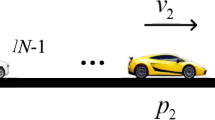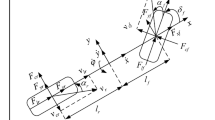Abstract
To improve the tracking efficiency of the platoon during driving and ensure the spacing safety between vehicles, a platoon tracking control strategy based on the adaptive neural network algorithm is developed. In this method, the nonlinear term in the vehicle model is estimated by the adaptive neural network, and the estimated value is used to compensate for the control input and enhance the tracking performance of the vehicle platoon. In addition, the estimation update law of target trajectory and adjacent vehicle acceleration is designed through the adaptive method, which relaxes the trajectory generation requirements of virtual vehicles, improves the tracking performance of vehicle platoon, reduces the measurement and communication burden in the platoon, and ensures the security and stability of vehicle platoon system. After constructing the vehicle and desired path model, the control objective is formulated, and the adaptive neural network algorithm controller is designed. Meanwhile, the stability of the controller is verified by the Lyapunov method. The feasibility of the proposed method is proved by simulation and experiment. Rigorous theoretical derivation and experiments confirm that the proposed strategy has obvious advantages over other existing strategies.
Similar content being viewed by others
References
D. Li, B. Zhang, and Y. **u, “Snake robots play an important role in social services and military needs,” The Innovation, vol. 3, no. 6, 100333, 2022.
E. Q. Wu, G. R. Zhou, and L. M. Zhu, “Rotated sphere haar wavelet and deep contractive auto-encoder network with fuzzy gaussian svm for pilot’s pupil center detection,” IEEE Transactions on Cybernetics, vol. 51, no. 1, pp. 332–345, 2019.
E. Q. Wu, D. Hu, and P. Y. Deng, “Nonparametric Bayesian prior inducing deep network for automatic detection of cognitive status,” IEEE Transactions on Cybernetics, vol. 51, no. 11, pp. 5483–5496, 2020.
Z. Pan, D. Wang, H. Deng, and K. Li, “A virtual spring method for the multi-robot path planning and formation control,” International Journal of Control, Automation, and Systems, vol. 17, no. 5, pp. 1272–1282, 2019.
Y. Li, C. Tang, S. Peeta, and Y. Wang, “Integral-sliding-mode braking control for a connected vehicle platoon: Theory and application,” IEEE Transactions on Industrial Electronics, vol. 66, no. 6, pp. 4618–4628, 2018.
J. Bai, J. Du, T. Li, and Y. Chen, “Trajectory tracking control for wheeled mobile robots with kinematic parameter uncertainty,” International Journal of Control, Automation, and Systems, vol. 20, no. 5, pp. 1632–1639, 2022.
Z. Huang, D. Chu, C. Wu, and Y. He, “Path planning and cooperative control for automated vehicle platoon using hybrid automata,” IEEE Transactions on Intelligent Transportation Systems, vol. 20, no. 3, pp. 959–974, 2018.
J. J. Zhang, Z. L. Fang, and Z. Q. Zhang, “Trajectory tracking control of nonholonomic wheeled mobile robots using model predictive control subjected to lyapunov-based input constraints,” International Journal of Control, Automation, and Systems, vol. 20, no. 5, pp. 1640–1651, 2022.
J. Ding, H. Pei, J. Hu, and Y. Zhang, “Cooperative adaptive cruise control in vehicle platoon under environment of i-VICS,” Proc. of 21st International Conference on Intelligent Transportation Systems (ITSC), pp. 1246–1251, 2018.
K. Li, W. Ni, E. Tovar, and M. Guizani, “Optimal rate-adaptive data dissemination in vehicular platoons,” IEEE Transactions on Intelligent Transportation Systems, vol. 21, no. 10, pp. 4241–4251, 2019.
X. Qin, Y. Bian, and Z. Hu, “Distributed vehicular platoon control considering communication topology disturbances,” Proc. of IEEE 23rd International Conference on Intelligent Transportation Systems (ITSC), pp. 1–6, 2020.
J. Wang, F. Ma, and Y. Yang, “Adaptive event-triggered platoon control under unreliable communication links,” IEEE Transactions on Intelligent Transportation Systems, vol. 23, no. 3, pp. 1924–1935, 2022.
P. Wang, H. Deng, J. Zhang, L. Wang, M. Zhang, and Y. Li, “Model predictive control for connected vehicle platoon under switching communication topology,” IEEE Transactions on Intelligent Transportation Systems, vol. 23, no. 7, 7817–7830, 2022.
Z. Yang, J. Huang, Z. Hu, D. Yang, and Z. Zhong, “Safety-guaranteed constraint-oriented modelling and control for bidirectional vehicular platoons,” IET Control Theory & Applications, vol. 14, no. 19, pp. 3116–3127, 2020.
C. Pan, Y. Chen, and Y. Liu, “Adaptive resilient control for interconnected vehicular platoon with fault and saturation,” IEEE Transactions on Intelligent Transportation Systems, vol. 23, no. 8, pp. 10210–10222, 2022.
E. Q. Wu, M. Zhou, D. Hu, L. Zhu, Z. Tang, X. Y. Qiu, P. Y. Deng, L. M. Zhu, and H. Ren, “Self-paced dynamic infinite mixture model for fatigue evaluation of pilots’ brains,” IEEE Transactions on Cybernetics, vol. 52, no. 7, pp. 5623–5638, 2020.
E. Q. Wu, C. T. Lin, L. M. Zhu, Z. Tang, Y. W. Jie, and G. R. Zhou, “Fatigue detection of pilots’ brain through brains cognitive map and multilayer latent incremental learning model,” IEEE Transactions on Cybernetics, vol. 52, no. 11, pp. 12302–12314, 2021.
T. Yu, J. Liu, and Y. Zeng, “Stability analysis of genetic regulatory networks with switching parameters and time delays,” IEEE Transactions on Neural Networks and Learning Systems, vol. 29, no. 7, pp. 3047–3058, 2017.
E. Q. Wu, Z. Tang, and Y. Yao, “Scalable gamma-driven multilayer network for brain workload detection through functional near-infrared spectroscopy,” IEEE Transactions on Cybernetics, vol. 52, no. 11, pp. 12464–12478, 2022.
X. G. Guo, J. L. Wang, and F. Liao, “Cnn-based distributed adaptive control for vehicle-following platoon with input saturation,” IEEE Transactions on Intelligent Transportation Systems, vol. 19, no. 10, pp. 3121–3132, 2017.
X. Guo, J. Wang, F. Liao, and R. S. H. Teo, “Neuroadaptive quantized pid sliding-mode control for heterogeneous vehicular platoon with unknown actuator deadzone,” International Journal of Robust and Nonlinear Control, vol. 29, no. 1, pp. 188–208, 2019.
G. Fiengo, D. G. Lui, and A. Petrillo, “Distributed robust pid control for leader tracking in uncertain connected ground vehicles with v2v communication delay,” IEEE/ASME Transactions on Mechatronics, vol. 24, no. 3, pp. 1153–1165, 2019.
X. Qin, Y. Bian, Z. Yang, and M. Hu, “Distributed vehicular platoon control with heterogeneous communication delays,” Proc. of Chinese Control And Decision Conference (CCDC), pp. 3219–3224, 2020.
Y. Liu, D. Yao, H. Li, and R. Lu, “Distributed cooperative compound tracking control for a platoon of vehicles with adaptive nn,” IEEE Transactions on Cybernetics, vol. 52, no. 7, pp. 7039–7048, 2021.
H. Chehardoli and M. R. Homaienezhad, “A new virtual leader-following consensus protocol to internal and string stability analysis of longitudinal platoon of vehicles with generic network topology under communication and parasitic delays,” Journal of Computational Applied Mechanics, vol. 48, no. 2, pp. 345–356, 2017.
Y. Ghaedsharaf, C. Somarakis, and N. Motee, “Performance of second-order platoon of vehicles in presence of time-delay and noise,” Proc. of Annual American Control Conference (ACC), pp. 4887–4892, 2018.
D. Jia, D. Ngoduy, and H. L. Vu, “A multiclass microscopic model for heterogeneous platoon with vehicle-to-vehicle communication,” Transportmetrica B: Transport Dynamics, vol. 7, no. 1, pp. 311–335, 2018.
Z. Pan, Z. Sun, and H. Deng, and D. Li, “A multilayer graph for multiagent formation and trajectory tracking control based on MPC algorithm,” IEEE Transactions on Cybernetics, vol. 52, no. 12, pp. 13586–13597, 2022.
D. Li, H. Deng, Z. Pan, and Y. **u, “Collaborative obstacle avoidance algorithm of multiple bionic snake robots in fluid based on IB-LBM,” ISA transactions, vol. 122, pp. 271–280, 2022.
N. Zhou and Y. **a, “Coordination control of multiple euler-lagrange systems for escorting mission,” International Journal of Robust and Nonlinear Control, vol. 25, no. 18, pp. 3596–3616, 2015.
D. Li, Z. Pan, H. Deng, and T. Peng, “Trajectory tracking control law of multi-joint snake-like robot based on improved snake-like curve in flow field,” International Journal of Advanced Robotic Systems, vol. 16, no. 2, 2019.
G. Wen, C. P. Chen, and Z. Liu, “Neural network-based adaptive leader-following consensus control for a class of nonlinear multiagent state-delay systems,” IEEE transactions on cybernetics, vol. 47, no. 8, pp. 2151–2160, 2016.
W. Zheng, T. L. Tang, and H. B. Wang, “Distributed lead-erless consensus for a class of multiple underactuated systems with unknown nonlinearities and external disturbances,” International Journal of Control, Automation, and Systems, vol. 20, no. 5, pp. 1449–1460, 2022.
D. Li, Z. Pan, and H. Deng, “Two-dimensional obstacle avoidance control algorithm for snake-like robot in water based on immersed boundary-lattice boltzmann method and improved artificial potential field method,” Transactions of the Institute of Measurement and Control, vol. 42, no. 10, pp. 1840–1857, 2020.
D. Li, Z. Pan, H. Deng, and L. Hu, “Adaptive path following controller of a multijoint snake robot based on the improved serpenoid curve,” IEEE Transactions on Industrial Electronics, vol. 69, no. 4, pp. 3831–3842, 2021.
J. Huang, N. Zhou, and M. Cao, “Adaptive fuzzy behavioral control of second-order autonomous agents with prioritized missions: Theory and experiments,” IEEE Transactions on Industrial Electronics, vol. 66, no. 12, pp. 9612–9622, 2019.
J. J. E. Slotine and W. Li, Applied Nonlinear Control, Prentice Hall, Englewood Cliffs, NJ, vol. 199, no. 1, 1991.
G. H. Hardy, J. E. Littlewood, and G. Pólya, Inequalities, Cambridge University Press, Cambridge, England, U.K, 1952.
L. Chen and J. Fang, “Adaptive continuous sliding mode control for fractional-order systems with uncertainties and unknown control gains,” International Journal of Control, Automation, and Systems, vol. 20, no. 5, pp. 1509–1520, 2022.
Author information
Authors and Affiliations
Corresponding author
Ethics declarations
The authors declare that there is no competing financial interest or personal relationship that could have appeared to influence the work reported in this paper.
Additional information
Publisher’s Note Springer Nature remains neutral with regard to jurisdictional claims in published maps and institutional affiliations.
This work was supported in part by the National Natural Science Foundation of China under Grants 61603094.
Jie Huang received his B.E. degree in electrical engineering and automation, an M.E. degree in control engineering from Fuzhou University, China, in 2005 and 2010, respectively, and a Ph.D. degree in control science and engineering from Bei**g Institute of Technology, Bei**g, China in 2015. From 2005 to 2015, he was a lecturer with Fujian Institute of Education, Fuzhou, China. From 2014 to 2016, he was postdoctoral researcher with the Faculty of Mathematics and Natural Sciences, University of Groningen, the Netherlands. From 2016 to 2018, he held lecturer appointments with the Faculty of Science and Engineering, University of Groningen, the Netherlands. He is currently a full professor of robotic and control with the College of Electrical Engineering and Automation, Fuzhou University, China and the director of the 5G+ Industrial Internet Institute, Fuzhou University, China. He is the vice-president of the Fujian Automation Association, Fujian Province, China. His research interests include autonomous robots, complex network dynamics, and multi-agent systems.
Jianfei Chen received his B.E. degree in measurement and control technology and instrumentation from Qingdao University of Science and Technology, Shandong, China, in 2020. He is now an M.E. student at Fuzhou University, Fuzhou, China. His research interests include multi-agent systems optimization.
Hongsheng Yang received his B.E. degree in automation, and an M.E. degree in control engineering from Fuzhou University, China, in 2019 and 2022, respectively. His research interests include tracking control and multi-agent systems.
Dongfang Li graduated from Nan**g University of Aeronautics and Astronautics in 2014, China. In 2021, he received his Ph.D. degree in mechanical engineering from the Bei**g University of Technology, China. He is currently an Associate Professor at the School of Electrical Engineering and Automation, Fuzhou University, Fuzhou, China. His research orientations are path-following control and obstacle avoidance control of snake robots.
Rights and permissions
About this article
Cite this article
Huang, J., Chen, J., Yang, H. et al. Vehicle Platoon Tracking Control Based on Adaptive Neural Network Algorithm. Int. J. Control Autom. Syst. 21, 3405–3418 (2023). https://doi.org/10.1007/s12555-022-0445-5
Received:
Revised:
Accepted:
Published:
Issue Date:
DOI: https://doi.org/10.1007/s12555-022-0445-5




